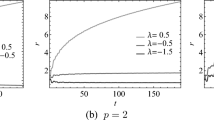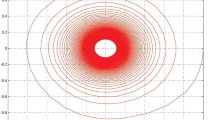Abstract—
This article proposes a model that generalizes the well-known equations of the nonlinear theory of oscillations (Van der Pol and Rayleigh equations), the limit cycles of which are the curves of the phase plane, determined by the total energy of oscillations in the absence of dissipation/energy inflow into the system. By changing the parameters of the system and the type of force action, it is possible to set the oscillation characteristics that are resistant to disturbances. The phase portraits of the system are considered, including the case of multiply connected limit cycles.



Similar content being viewed by others
REFERENCES
V. F. Zhuravlev and D. M. Klimov, Wave Solid-State Gyroscope (Nauka, Moscow, 1985) [in Russian].
D. M. Klimov, V. F. Zhuravlev, and Yu. K. Zhbanov, Quartz Hemispherical Resonator (Wave Solid-State Gyroscope) (Kim L.A, Moscow, 2017) [in Russian].
V. F. Zhuravlev, “Wave solid-state gyroscope: modern state, some aspects,” Aktual. Probl. Aviats. Aerokosmicheskikh Sist.: Protsessy, Modeli, Eksperim., No. 2 (33), 118–123 (2011).
V. F. Zhuravlev, “Van der Pol’s controlled 2D oscillator,” Nelineinaya Din. 12 (2), 211–222 (2016).
T. Yi, X. Z. Wu, D. B. Xiao, X. Xi, and Y. Q. Tan, “A novel cupped solid-state wave gyroscope,” Appl. Mech. Mater. 110–116, 715–722 (2011). http://www.scientific.net/amm.110-116.715
S. Negri, E. Labarre, C. Lignon, E. Brunshtein, and E. Salaün, “A new generation of IRS with innovative architecture based on HRG for satellite launch vehicles,” Gyroscopy Navig. 7 (3), 223–230 (2016).
G. A. Trutnev, “Model of the hemispherical resonator gyroscope construction damping,” Vestn. Udmurt. Univ. Mat. Mekh. Komp’yut. Nauki 29 (1), 84–91 (2019).
G. Yi, Y. Xie, Z. Qi, and B. Xi, “Modeling of acceleration influence on hemispherical resonator gyro forsing system,” Math. Probl. Eng. 2015, ID 104041 (2015). https://doi.org/10.1155/2015/104041
S. V. Seregin, “The influence of shape imperfections on the vibrations of a ring resonator of a wave solid-state gyroscope,” Nelinaya Din. 13 (3), 423–431 (2017).
Yu. G. Martynenko, I. V. Merkur’ev, and V. V. Podalkov, “Control of nonlinear vibrations of vibrating ring microgyroscope,” Mech. Solids 43, 379–389 (2008).
V. Ph. Zhuravlev, “Van der Pol oscillator. Technical applications,” Mech. Solids 55, 132–137 (2020).
B. Van der Pol, “On relaxation-oscillations,” London, Edinburgh Dublin Phil. Mag. J. Sci. 2 (7), 978–992. (1927).
J. W. Strutt, The Theory of Sound (Macmillan and Co., London, 1894), Vol. 1.
Funding
This work was supported by the state assignments АААА-А20-120011690138-6 and АААА-А20-120011690132-4.
Author information
Authors and Affiliations
Corresponding author
Additional information
Translated by L. Trubitsyna
About this article
Cite this article
Nesterov, S.V., Baydulov, V.G. Class of Auto-Oscillating Systems. Mech. Solids 55, 1157–1161 (2020). https://doi.org/10.3103/S0025654420080208
Received:
Revised:
Accepted:
Published:
Issue Date:
DOI: https://doi.org/10.3103/S0025654420080208




